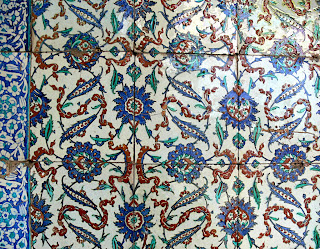
 Tiles are not only decorative. In one shop in Istanbul we found a map of the old Sultanahmet district. If you look carefully at the details and then refer to a "Google Maps" view of the corresponding section of the city, you will see the panel of tiles can serve as a reasonably useful map of that section of the city.
Tiles are not only decorative. In one shop in Istanbul we found a map of the old Sultanahmet district. If you look carefully at the details and then refer to a "Google Maps" view of the corresponding section of the city, you will see the panel of tiles can serve as a reasonably useful map of that section of the city.Unfortunately, not all tiles are high quality. Many tourist-oriented stores and stalls sell very low quality samples such as the round ones shown here. These were found abandoned on the street in the city of Uchisar, possibly awaiting the return of tourist season?




































